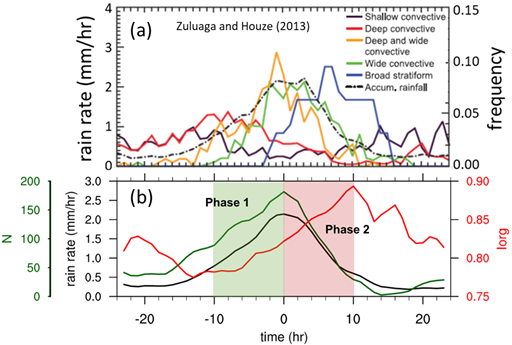Quantification of convective clustering
Submitter:
Kim, Daehyun — University of Washington
Area of research:
Cloud Processes
Journal Reference:
Science
We successfully quantified the degree to which precipitating cumulus clouds are spatially aggregated at scales larger than the size of individual clouds by use of ground-based radar observations over the tropical ocean. We also found that the nature of convective clustering during the developing phase with increasing number of cumulus clouds is different from that of the decaying phase in which the number of convective clouds decreases.
Impact
The computer models that we use for weather and climate prediction are unable to represent how organized cumulus clouds are because our understanding of the mechanism through which cumulus clouds aggregate is limited. Our results suggest a few specific mechanisms that need to be included in the computer models to correctly represent tropical cumulus clouds, and which will provide guidance to improve those models.
Summary
To objectively quantify the degree of convective clustering (i.e., the spatial clustering of cumulus clouds) using scalar metrics derived from ground-based radar data, we first identify convective elements from radar reflectivity using a rain type classification algorithm. We then apply scalar clustering metrics to the identified convective elements to test their ability to quantify convective clustering during the observed two-day rain episodes. We found that, among other metrics, the Organization Index (Iorg) of Tompkins and Semie best captures the observed convective clustering.
By inspecting the time evolution of Iorg together with that of N, the number of convective elements in the domain, we reveal two distinct phases of convective clustering during the two-day rain events, which we name Phase 1 and 2 clustering, respectively. In Phase 1 clustering, which corresponds to the developing stage of overall convective activity in the domain, N increases and the new convective clouds tend to form preferentially near the existing ones, leading to a higher degree of organization. In Phase 2 clustering, on the contrary, aggregation of convection occurs while N decreases with the environment being stabilized. We found that, during this decaying stage, convective clouds keep organized as they are forced to form over a limited area by mesoscale circulation associated with stratiform clouds.



